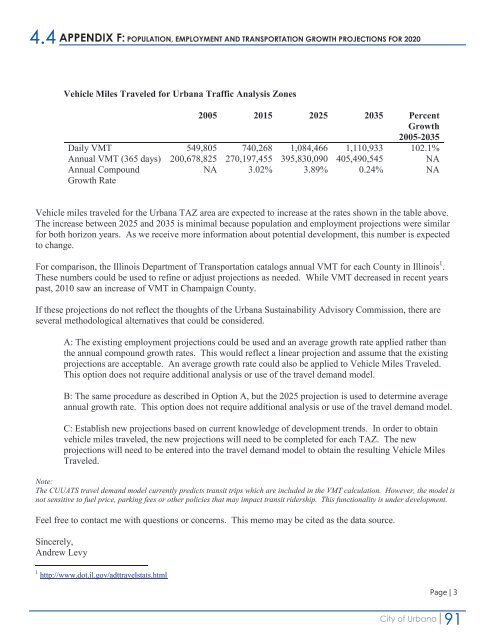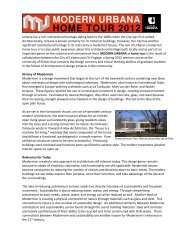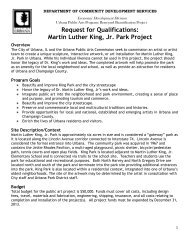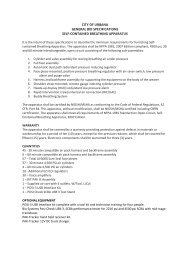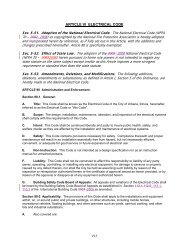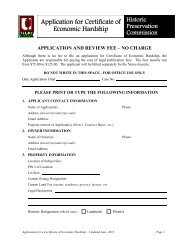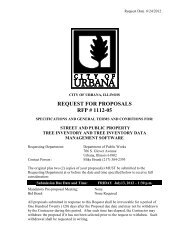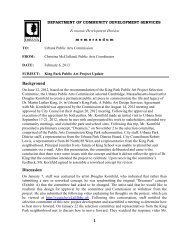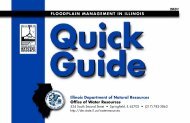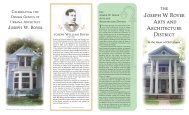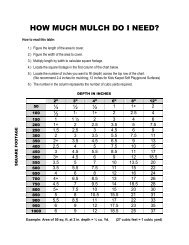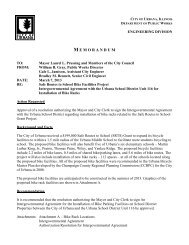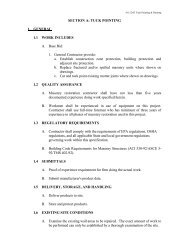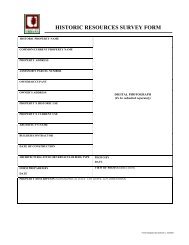CLIMATE ACTION PLAN - City of Urbana
CLIMATE ACTION PLAN - City of Urbana
CLIMATE ACTION PLAN - City of Urbana
- No tags were found...
Create successful ePaper yourself
Turn your PDF publications into a flip-book with our unique Google optimized e-Paper software.
4.4 APPENDIX F: POPULATION, EMPLOYMENT AND TRANSPORTATION GROWTH PROJECTIONS FOR 2020<br />
Vehicle Miles Traveled for <strong>Urbana</strong> Traffic Analysis Zones<br />
2005 2015 2025 2035 Percent<br />
Growth<br />
2005-2035<br />
Daily VMT 549,805 740,268 1,084,466 1,110,933 102.1%<br />
Annual VMT (365 days) 200,678,825 270,197,455 395,830,090 405,490,545 NA<br />
Annual Compound<br />
Growth Rate<br />
NA 3.02% 3.89% 0.24% NA<br />
Vehicle miles traveled for the <strong>Urbana</strong> TAZ area are expected to increase at the rates shown in the table above.<br />
The increase between 2025 and 2035 is minimal because population and employment projections were similar<br />
for both horizon years. As we receive more information about potential development, this number is expected<br />
to change.<br />
For comparison, the Illinois Department <strong>of</strong> Transportation catalogs annual VMT for each County in Illinois 1 .<br />
These numbers could be used to refine or adjust projections as needed. While VMT decreased in recent years<br />
past, 2010 saw an increase <strong>of</strong> VMT in Champaign County.<br />
If these projections do not reflect the thoughts <strong>of</strong> the <strong>Urbana</strong> Sustainability Advisory Commission, there are<br />
several methodological alternatives that could be considered.<br />
A: The existing employment projections could be used and an average growth rate applied rather than<br />
the annual compound growth rates. This would reflect a linear projection and assume that the existing<br />
projections are acceptable. An average growth rate could also be applied to Vehicle Miles Traveled.<br />
This option does not require additional analysis or use <strong>of</strong> the travel demand model.<br />
B: The same procedure as described in Option A, but the 2025 projection is used to determine average<br />
annual growth rate. This option does not require additional analysis or use <strong>of</strong> the travel demand model.<br />
C: Establish new projections based on current knowledge <strong>of</strong> development trends. In order to obtain<br />
vehicle miles traveled, the new projections will need to be completed for each TAZ. The new<br />
projections will need to be entered into the travel demand model to obtain the resulting Vehicle Miles<br />
Traveled.<br />
Note:<br />
The CUUATS travel demand model currently predicts transit trips which are included in the VMT calculation. However, the model is<br />
not sensitive to fuel price, parking fees or other policies that may impact transit ridership. This functionality is under development.<br />
Feel free to contact me with questions or concerns. This memo may be cited as the data source.<br />
Sincerely,<br />
Andrew Levy<br />
1 http://www.dot.il.gov/adttravelstats.html<br />
Page | 3<br />
<strong>City</strong> <strong>of</strong> <strong>Urbana</strong><br />
91


